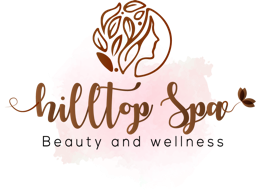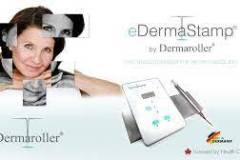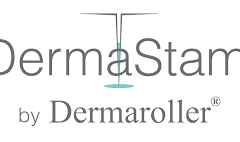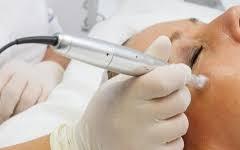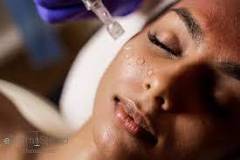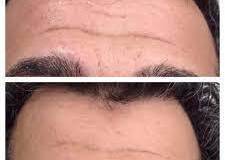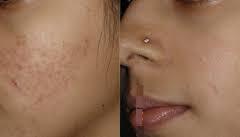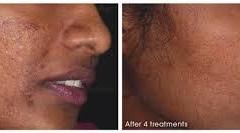| Session Type | Price |
|---|---|
| 1 Session | $299 |
| Package of 3 | $749 |
What is it
Micro-needling(CIT) is a minimally invasive procedure that involves using a device with tiny, fine needles to create controlled micro-injuries or punctures on the skin’s surface. The process of micro-needling stimulates the body’s natural healing response, which leads to the production of collagen and elastin, two essential proteins that help keep the skin looking youthful and firm.
During a microneedling session, will use a handheld device with a series of tiny needles, which will puncture the skin at a precise depth, depending on the specific skin concerns being addressed. The needles create tiny channels in the skin, which can trigger the production of new collagen and elastin, leading to improved skin texture, tone, and overall appearance.
Commonly Asked Questions
Who can get it ?
Microneedling is suitable for most skin types and concerns. It is great for helping with:
- Maturing skin
- Acne scars
- Fine lines/Wrinkles
- Improving skin texture
- Hyper-pigmentation/uneven skin tone
Your skin will look brighter, healthier, and smoother once healed. Multiple sessions will be required for long-term results and a maintenance plan.
Who Shoudnt Get It ?
We always recommend getting a consultation done beforehand to see if the service is right for you. Here are some conditions we can not work over:
- Open wounds or active acne
- Cold sore breakouts
- Eczema or Psoriasis
- Using Accutane in last 6 months
- Recent use of Retin-A/Retinol/Acids
- Sunburns
What Are The Benefits ?
We usually recommend 4-6 sessions, with one session a month.
Here are some of the key benefits of microneedling:
- Stimulates collagen production: Microneedling stimulates the production of collagen and elastin in the skin, which can improve skin texture and firmness. Collagen is a protein that provides structure to the skin, while elastin helps the skin maintain its elasticity.
- Reduces the appearance of fine lines and wrinkles: helps to reduce the appearance of fine lines and wrinkles on the face, neck, and décolletage, by promoting the growth of new collagen fibers.
- Improves skin texture and tone: helps to improve the overall texture and tone of the skin, by reducing the appearance of scars, hyperpigmentation, and other skin imperfections.
- Increases product absorption: by creating micro-channels in the skin, it allows topical skincare products to penetrate deeper into the skin, increasing their effectiveness.
- Safe for all skin types: it is safe for all skin types, and can be used to treat a variety of skin concerns, including acne scars, stretch marks, and sun damage.
- Minimal downtime: while there may be some mild redness and swelling after the procedure, there is minimal downtime required after microneedling. Most people can return to their normal activities within a day or two.
It can be a great option for those looking for a non-invasive treatment to address fine lines, wrinkles, scars, and other skin imperfections.
What To Expect After ?
Immediately, you will notice your skin looking irritated and red. This is all a normal response to the “injuries” made. This will subside within a few days.
You may feel an immediate tightness to the skin, which is also normal. We highly recommend keeping the skin moisturized during this period.
It is best to let the skin heal for 48-72 hours after procedure before applying additional products. Avoid any exfoliating products for 1 week.
Be cautious of sun exposure in the days following and wear SPF for skin protection.
How soon after treatment can i return to my daily activity ?
eDermastamp treatments are minimally invasive, leaving your skin red (looking much like a sunburn) for 24-36 hours. Some clients report a bit of tenderness. We recommended avoiding makeup for 24 hours after the treatment and using light mineral makeup afterward. Clients report that post-treatment redness diminishes upon subsequent sessions. Following post-care instructions given after treatment will give the best result.
Is the eDermastamp suitable for all skin tones ?
Yes, the eDermatamp is suitable for all skin tones.
How does the eDermastamp feel ?
Since we use a numbing cream prior to the treatment, most clients report a sensation similar to exfoliation.
How many eDermastamp sessions are recommended ?
In general, we recommend 4-6 treatments, 6-8 weeks apart. Results vary, and more sessions may be needed.
What is Micro-needling?
Micro-needling is a form of collagen induction therapy. It has become a popular treatment in aesthetics, used to reduce the appearance of fine lines, acne scars and improve the skin’s overall appearance. During this procedure, small injuries are made to the skin with sanitized and small needles. The skin then produces collagen and elastin at the sites of injury in order to naturally repair itself. The procedure also creates superficial micro-channels through which topical skin-safe gels, creams and serums can be penetrated deeper into the dermis and can help improve the appearance of the skin.
What conditions can be treated with microneedling?
Microneedling treatments can address a variety of conditions including but not limited to:
- Reducing the appearance of acne scars
- tightening the skin and restoring elasticity
- reduced appearances of stretch marks
- minimizing the appearance of pores and smoothing overall of complexion
- reduction in the appearance of scarring anywhere on the body
- reduction in the appearance of pigmentation marks
- reducing the appearance of texturizing of skin
Which areas of the body can be treated with microneedling?
The procedure can be carried out anywhere on the body. Some common treatment areas are the face, neck, décolleté and hands to help reduce the look of aging. The thighs, buttocks, hips and abdomen are also popular to minimise the appearance of stretch marks and tighten the skin.
How does microneedling work?
Microeedling works by encouraging your skin you can make more collagen. The pin pricks from the procedure causes light injury to the skin.This process generates new collagen-rich tissue as the skin repairs itself naturally. Blood supply is enhanced and over the following weeks the skin becomes thicker, plumper with an increasingly vibrant and youthful complexion.
What happens during the appointment?
The treatment area will be thoroughly cleansed, and a topical anaesthetic cream will be applied to maximise patient comfort during the procedure. This is left on for around 20-30 minutes for a mild facial rejuvenation treatment and up to an hour for a deeper treatment such as scar reduction or intense skin tightening and rejuvenation.
Numbing the treatment area is often the longest part of the treatment and once the cream is removed the needling procedure can start. The treatment can take anything from 10 to 30 minutes depending on the size of the area and the depth required for treatment. During deeper treatments especially there will be visible micro bleeding which is the required end state of the treatment.
The skin will be cleansed following the treatment, and the appropriate skin care applied, enabling the products to sink deep into the dermal layers for optimum results.
Does the treatment hurt?
A topical local anaesthetic will be applied and therefore the treatment should not be painful. There may be some minor discomfort in sensitive areas. During a deeper treatment some patients feel a minor stinging sensation.
How will I look after the treatment?
Patients generally look flushed, resembling having a moderate sunburn and the skin will feel warm and slightly tight. This reduces over the following 24-48 hours. Full aftercare instructions will be given during your appointment.
How long will it be before I can see results?
This depends on your bodies cell renewal process which generally slows down when we age. Results are normally visible within the first week, but optimum results can take up to six weeks as the skin continues to repair itself. The regeneration process will continue for several months and for best results, multiple sessions are recommended.
How many treatments will I need?
The number of treatments required will depend on several factors including age, the area being treated, the condition you are receiving treatment for and skin condition. Generally, a course of 4-6 treatments spaced between 4 and 8 weeks apart is enough. Once you are satisfied with your results, we recommended a single session treatment be performed every six months to maintain the results.
Are there any side effects?
Microneedling is safe, with minimal side effects or associated risks. The skin will appear red for up to 48 hours following the procedure with some minor bleeding and bruising possible. The area will feel warm, dry or tight for a short while. Other side effects typically include minor flaking or dryness of the skin, and in rare cases some scabbing . If you have a history of cold sores, they may reappear after treatment.
Who should not have microneedling?
Microneedling is suitable for most skin types, however, it is not suitable for patients within the following:
- anyone who has used Roaccutane/Accutane (isotretinoin) within the last 6 months.
- having open wounds, cuts or abrasions to the skin.
- have had radiation treatment within the last year.
- have a current outbreak of herpes simplex (cold sores) active acne, or any other infection/chronic skin conditions in the area to be treated.
- have areas of the skin that are numb or lack sensation.
- Are pregnant or breast feeding.
- have a history of keloid or hypertrophic scars or poor wound healing.
Does microneedling work?
Various clinical studies have shown microneedling to be an effective non-surgical treatment for a variety of skin conditions. These include ageing, (wrinkles, fine lines, and stretch marks), scarring (acne and surgical), as well as cellulite and hyperpigmentation.
In addition, further studies have shown that microneedling is a better treatment option than dermabrasion, chemical peels, and laser resurfacing. It is clinically proven to be effective in its ability to stimulate collagen and elastin production.
Instructions
Pre-Care Instructions
1. Consultation: Schedule a consultation to discuss your skin concerns, medical history, and determine if microneedling is suitable for you.
2. Avoid Sun Exposure: Minimize sun exposure and use sunscreen regularly in the weeks leading up to your microneedling treatment. Sunburned or tanned skin should not undergo microneedling.
3. Skincare Products: Discontinue the use of retinoids, acids, exfoliating products, and other harsh skincare ingredients for at least one week before your microneedling session, as they can increase skin sensitivity.
4. Skin Infections or Breakouts: If you have active cold sores, or significant breakouts, it is advisable to postpone microneedling until the skin has healed to avoid spreading or worsening the condition.
Post-Care Instructions
1. Gentle Cleansing: Use a gentle cleanser to cleanse the treated area for the first 48 hours after microneedling. Avoid harsh or abrasive products that may irritate the skin.
2. Moisturize: Apply the soothing and hydrating moisturizer that was given to you during your treatment, to the skin to help with recovery. Skin may feel very tight and dry, so please use any extra Hyaluronic acid in the syringe given to you and apply thoroughly as needed. Advisable to use chilled aloe vera gel after the 48hr period.
3. Sun Protection: Protect your skin from the sun by applying a broad-spectrum sunscreen with at least SPF 30 regularly. Avoid direct sun exposure for the first few days after, as the skin may be more sensitive.
4. Makeup Restrictions: Avoid wearing makeup for at least 48 hours post-treatment to allow the skin to heal. If you do decide to wear makeup, ensure that it is mineral and non-irritating.
5. Avoid Irritating Products: Refrain from using harsh skincare products such as exfoliants, retinoids, acids or alcohol-based toners for a few days after, as they can cause further irritation.
6. Physical Activity and Sweating: Avoid strenuous exercise and activities that may cause excessive sweating for the first 48 hours after, as sweat can irritate the treated skin.
7. Follow-up Treatments: Depending on your skin concerns, a series of sessions may be recommended. Follow the recommended treatment plan and spacing intervals for optimal results.
